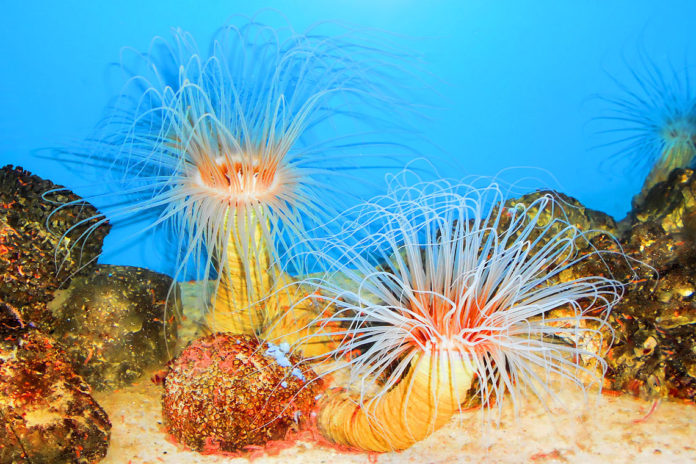Phylum Cnidaria include jellyfish, sea anemones, and sponges. These classes share basic phylum Cnidaria traits. Cnidaria are multicellular. They are also invertebrates. Invertebrates are animals with no backbone. Most Cnidarians are marine animals.
Cnidarians have radial symmetry. Unlike phylum Porifera they have body tissues. However, they lack organs. Instead, Cnidaria have two cell layers. These layers can perform several functions. They have only one opening for eating and excretion. Special stinging cells (nematocysts) capture food.
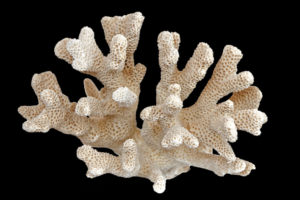
[Click on the thumbnail image for a full-sized image].
There are over 11,000 Cnidarian species. There are three main classes in the phylum.
The first class is Hydrozoa. Hydras are hydrozoans. Next, jellyfish belong to the Scyphozoa class. Finally, Anthozoa are corals and sea anemones.
Phylum Cnidaria Traits
Multicellular Organisms
Cnidarians are multicellular. However they lack organs. As a result, they lack respiratory and other systems. However, they do have tissues. Tissues are a group of similar cells that act together. When they act together they perform a special function.
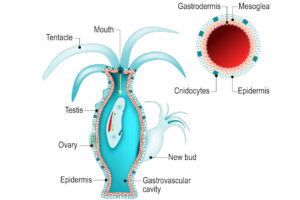
[Click on the thumbnail image for a full-sized image].
Cell Layers: Cnidarians have two cell layers. (See the hydra illustration). The epidermis is an outer protective layer of cells. The mesoglea is the middle layer. This is a jelly-like layer. Finally, the inner digestive layer of cells is the gastrodermis.
Body Cavity: A gastrovascular cavity is surrounded by these cell layers. A mouth is located at the top of the cavity. The mouth serves as the anus as well. The cavity is filled with water. The cavity is where digestion takes place.
Tentacles: A ring of tentacles surround the mouth of the hydra. Cnidocytes are special cells located in the tentacles. These are stinging cells used for capturing food. When stimulated, the cnidocytes will shoot out a barb that will stick in its prey. The barb then releases an immobilizing toxin. The tentacles then pull the prey into the gastrovascular cavity.
Respiration, Digestion and Excretion
Respiration: Cnidarians do not have a respiratory system. Instead, epidermis and gastrodermis cells absorb oxygen from the water. Then, carbon dioxide is expelled into the surrounding water.
Digestion and Excretion: Cnidarians may feed by predation. Tentacles and cnidocytes captures prey. After capture, food is moved into the body cavity. There, cells in the gastroderm digest the food. Gastroderm cells then absorb nutrients from the cavity. Nutrients are diffused or transported to the epidermal cells. Finally, waste materials are excreted by the mouth/anus.
Reproduction
Cnidarians reproduce sexually and asexually.

[Click on the thumbnail image for a full-sized image].
Sexual Reproduction: During sexual reproduction, jellyfish go through a complex life cycle. The cycle begins with an adult jellyfish. The jellyfish has male and female gonads. First, these gonads produce sperm and eggs.
An embryo develops after the eggs are fertilized by sperm. Next, the eggs hatch and free swimming planula larva are released. The larva settle on the ocean floor and develop into polyps. Each polyp will produce buds that create a colony of polyps.
In the next phase, the polyp colony develop into strobila. Strobila develop horizontal grooves. Eventually, the topmost segment breaks off along the groove. This segment is called an ephyra. An ephyra is a baby jellyfish. The ephyra then grows into an adult jellyfish.
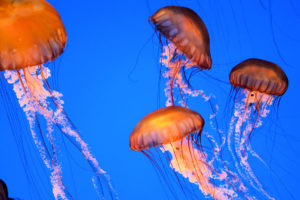
[Click on the thumbnail image for a full-sized image].
Asexual Reproduction: Cnidarians also reproduce asexually. For example, adult hydras can reproduce asexually by budding. On the other hand, juvenile jellyfish also go through budding during the polyp stage.
Nervous System
Phylum Cnidaria lacks a brain and nervous system. However, they have sensory structures called rhopalia. Rhopalia respond to stimuli such as light and pressure. In turn, the rhopalia can trigger muscle tissues.
Other Phylum Cnidaria Traits
Movement: The Cnidaria phylum uses different locomotion methods. Jellyfish use water jet propulsion to move. Other Cnidarians can move their base like snails. Others may somersault.
Symmetry: Cnidarians have radial symmetry.
Phylum Cnidaria Classification
Class Hydrozoa
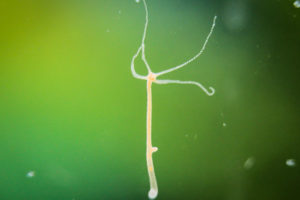
[Click on the thumbnail image for a full-sized image].
The hydra belongs to the Hydrozoa class. Hydrozoans are small, but prey on other animals. This class takes on different forms in their life cycle. They may be individual animals or belong to a colony. Most Hydrozoans live in marine environments.
Hydrozoans have a two stage life cycle. The polyp phase is sedentary. The medusa phase is mobile. Over 3,500 species of Hydrozoa exist.
Class Scyphozoa
Scyphozoa are the jellyfish. All are marine animals. They are much larger than Hydrozoans. The largest jellyfish can be two meters across. Like Hydrozoans, Scyphozoa has a two stage life cycle.
Slightly over 200 different species exist.
Class Anthozoa
Sea anemones and corals belong to Anthozoa. These animals exist only in the polyp stage. They do not have a medusae phase. Corals secrete a hard skeleton that forms into reefs. Over 6,000 species are known.
Reflections
Vocabulary
- asexual
- medusa
- polyp
Notes
- Cnidaria are multicellular. They are known for their stinging cells.
- Cnidaria have radial symmetry. They have body tissues but no organs.
- Anthozoa, Hydrozoa and Scyphozoa are the three major classes.
Bibliography
- A Animals Study Guide
- About Animals
- The Anemones, Corals and Jellyfish

